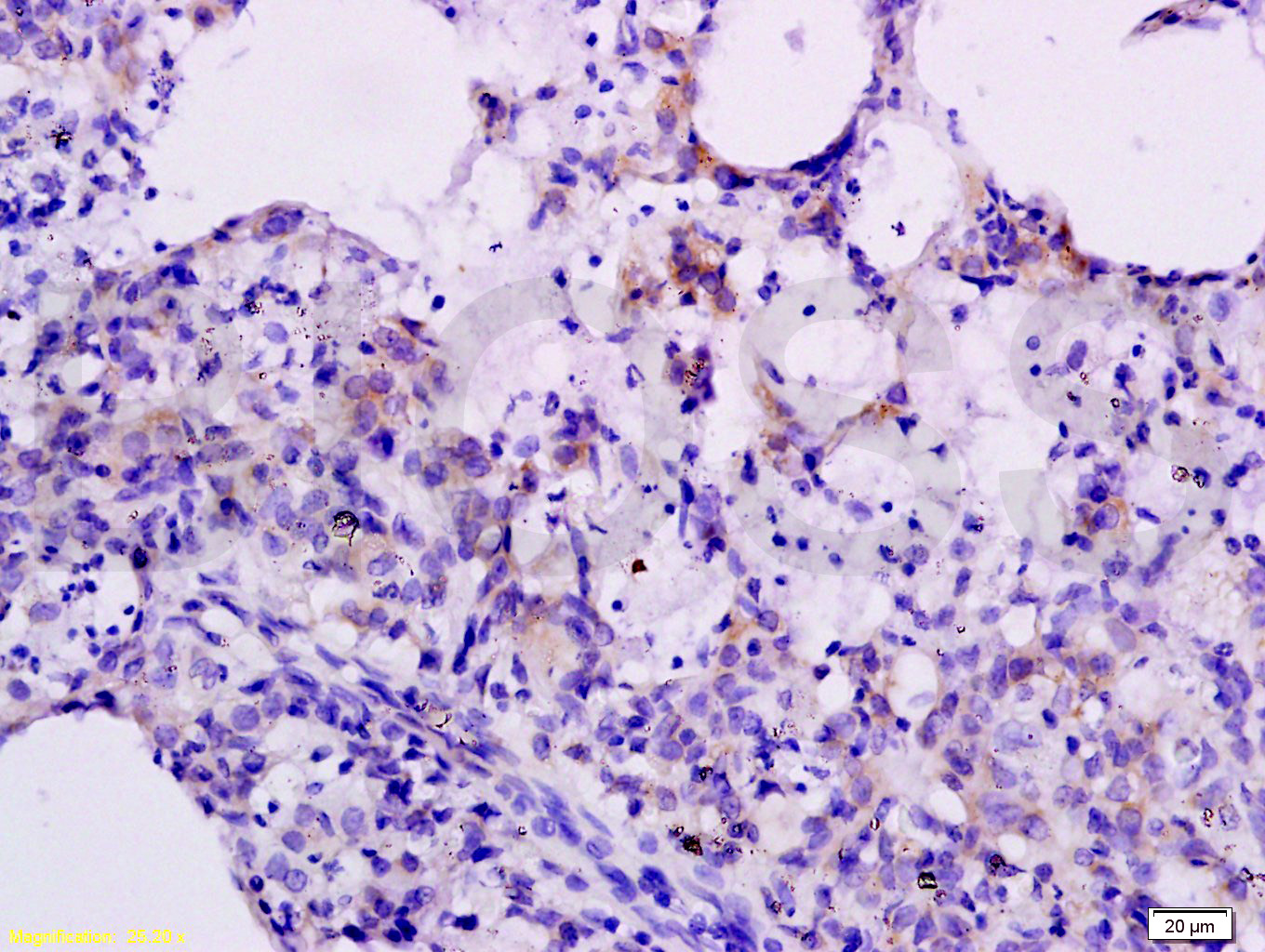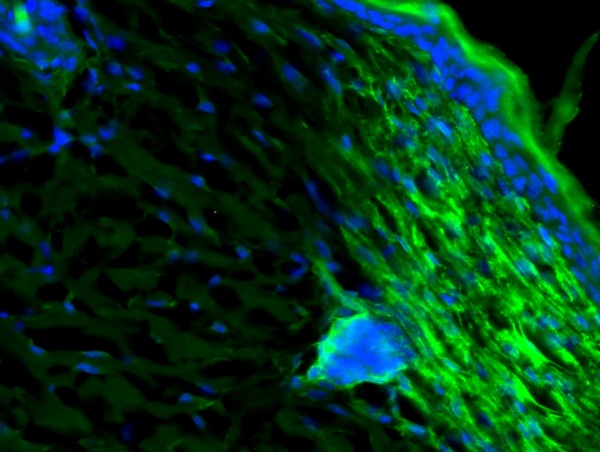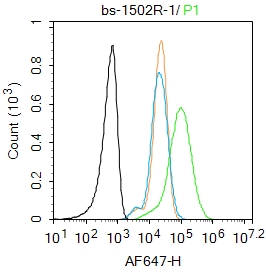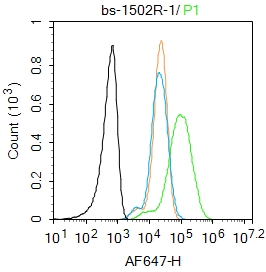CXCL10/IP10 Rabbit pAb
CXCL10/IP10 Rabbit pAb
- 产品详情
- 实验流程
- 背景知识
Application
| IHC-P, IHC-F, IF |
|---|---|
| Primary Accession | P17515 |
| Reactivity | Mouse |
| Host | Rabbit |
| Clonality | Polyclonal |
| Calculated MW | 10789 Da |
| Physical State | Liquid |
| Immunogen | KLH conjugated synthetic peptide derived from mouse CXCL10 |
| Epitope Specificity | 35-98/98 |
| Isotype | IgG |
| Purity | affinity purified by Protein A |
| Buffer | 0.01M TBS (pH7.4) with 1% BSA, 0.02% Proclin300 and 50% Glycerol. |
| SUBCELLULAR LOCATION | Secreted. |
| SIMILARITY | Belongs to the intercrine alpha (chemokine CxC) family. |
| Post-translational modifications | CXCL10(1-73) is produced by proteolytic cleavage after secretion from keratinocytes. |
| Important Note | This product as supplied is intended for research use only, not for use in human, therapeutic or diagnostic applications. |
| Background Descriptions | bs-1502P is one synthetic peptide derived from mouse CXCL10. Interferon-gamma-inducible 10 kD protein (IP-10), is a CXC chemokine with chemoattractant properties for CD4-positive T cells and inhibits early normal and leukemic hemopoietic progenitor proliferation. IP-10 is produced by a wide variety of cell types ranging from neutrophils and monocytes to hepatocytes, endothelial cells and keratinocytes. The cytokine is reported to be involved in a scala of inflammatory pathologies such as HIV encephalitis, cutaneous T cell lymphoma, chronic hepatitis and acute anterior uveitis. Various observations strongly suggest a role for the CXC chemokines IL-8 and IP-10 in the regulation of angiogenic activity in cancer and in idiopathic pulmonary fibrosis. |
| Gene ID | 15945 |
|---|---|
| Other Names | C-X-C motif chemokine 10, 10 kDa interferon gamma-induced protein, Gamma-IP10, IP-10, C7, Interferon-gamma induced protein CRG-2, Small-inducible cytokine B10, Cxcl10, Crg2, Ifi10, Inp10, Scyb10 |
| Dilution | IHC-P=1:100-500,IHC-F=1:100-500,IF=1:100-500,Flow-Cyt=1ug/Test |
| Format | 0.01M TBS(pH7.4) with 1% BSA, 0.09% (W/V) sodium azide and 50% Glyce |
| Storage | Store at -20 °C for one year. Avoid repeated freeze/thaw cycles. When reconstituted in sterile pH 7.4 0.01M PBS or diluent of antibody the antibody is stable for at least two weeks at 2-4 °C. |
| Name | Cxcl10 |
|---|---|
| Synonyms | Crg2, Ifi10, Inp10, Scyb10 |
| Function | Pro-inflammatory cytokine that is involved in a wide variety of processes such as chemotaxis, differentiation, and activation of peripheral immune cells, regulation of cell growth, apoptosis and modulation of angiostatic effects (By similarity) (PubMed:28623423). Plays thereby an important role during viral infections by stimulating the activation and migration of immune cells to the infected sites (PubMed:18624292, PubMed:19017990, PubMed:28468883). Mechanistically, binding of CXCL10 to the CXCR3 receptor activates G protein-mediated signaling and results in downstream activation of phospholipase C- dependent pathway, an increase in intracellular calcium production and actin reorganization. In turn, recruitment of activated Th1 lymphocytes occurs at sites of inflammation (By similarity). Activation of the CXCL10/CXCR3 axis also plays an important role in neurons in response to brain injury for activating microglia, the resident macrophage population of the central nervous system, and directing them to the lesion site. This recruitment is an essential element for neuronal reorganization (PubMed:15456824). |
| Cellular Location | Secreted {ECO:0000250|UniProtKB:P02778}. |
| Tissue Location | Expressed in the spleen, thymus, lymph nodes and liver (PubMed:8145049). Expressed in astrocytes, microglia, and neurons (PubMed:15456824). |
Research Areas
For Research Use Only. Not For Use In Diagnostic Procedures.
Application Protocols
Provided below are standard protocols that you may find useful for product applications.
BACKGROUND
This product as supplied is intended for research use only, not for use in human, therapeutic or diagnostic applications.
终于等到您。ABCEPTA(百远生物)抗体产品。
点击下方“我要评价 ”按钮提交您的反馈信息,您的反馈和评价是我们最宝贵的财富之一,
我们将在1-3个工作日内处理您的反馈信息。
如有疑问,联系:0512-88856768 tech-china@abcepta.com.
¥ 1,500.00
Cat# AP94159























 癌症的基本特征包括细胞增殖、血管生成、迁移、凋亡逃避机制和细胞永生等。找到癌症发生过程中这些通路的关键标记物和对应的抗体用于检测至关重要。
癌症的基本特征包括细胞增殖、血管生成、迁移、凋亡逃避机制和细胞永生等。找到癌症发生过程中这些通路的关键标记物和对应的抗体用于检测至关重要。 为您推荐一个泛素化位点预测神器——泛素化分析工具,可以为您的蛋白的泛素化位点作出预测和评分。
为您推荐一个泛素化位点预测神器——泛素化分析工具,可以为您的蛋白的泛素化位点作出预测和评分。 细胞自噬受体图形绘图工具为你的蛋白的细胞受体结合位点作出预测和评分,识别结合到自噬通路中的蛋白是非常重要的,便于让我们理解自噬在正常生理、病理过程中的作用,如发育、细胞分化、神经退化性疾病、压力条件下、感染和癌症。
细胞自噬受体图形绘图工具为你的蛋白的细胞受体结合位点作出预测和评分,识别结合到自噬通路中的蛋白是非常重要的,便于让我们理解自噬在正常生理、病理过程中的作用,如发育、细胞分化、神经退化性疾病、压力条件下、感染和癌症。









